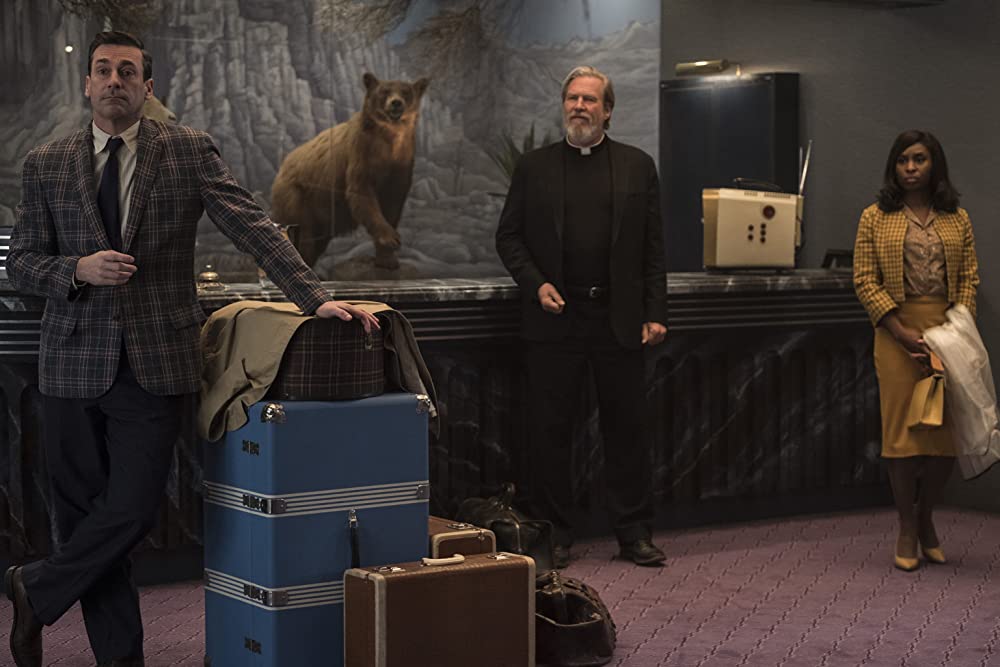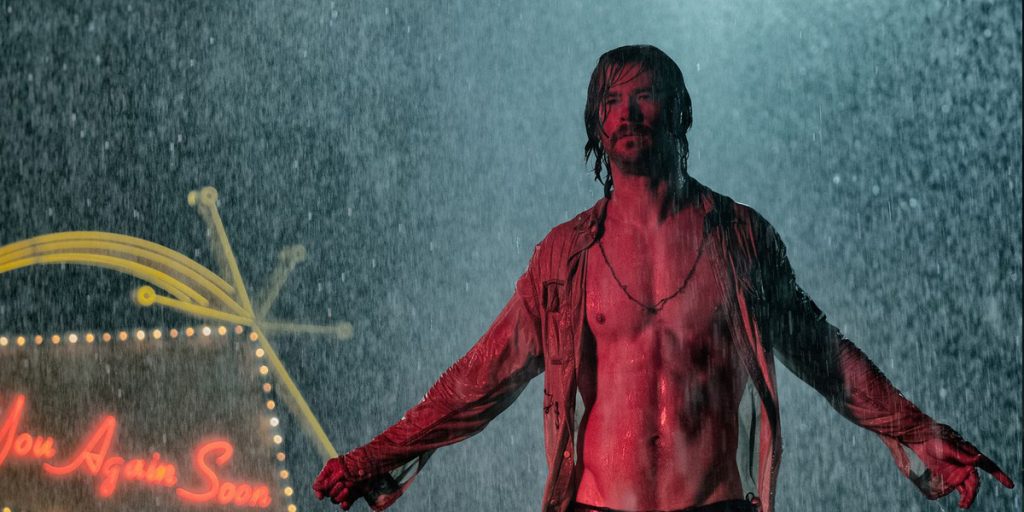Built upon layers of self-reflection, Bad Times At The El Royale is a throwback to star-powered bottle films of an era past rich in colors, characters, and social commentary.
In Bad Times At The El Royale, Drew Goddard’s throwback to Hollywood ensembles of an era past, the titular setting is both a character all its own and a cold, sinister context for what transpires within its mysterious walls. Once a bustling establishment for celebrities and politicians to luxuriously hide away from the world, the hotel has been largely forgotten even by the elite who used to frequent it, left now in all its dilapidating splendor sad and abandoned, ready to take its dark secrets to the grave. Until one afternoon, when four strangers converge in the lobby.
The film opens on Darlene (Cynthia Erivo) meeting Father Flynn (Jeff Bridges) along the bold red painted border between California and Nevada that splits the hotel directly in half. After exchanging pleasantries they head inside together, where there is waiting a Mr. Sullivan (Jon Hamm)—seemingly a caricature of 1960’s charisma—who insists on the honeymoon suite for himself. The receptionist is nowhere to be found, and emerges disheveled only after Darlene pounds on his door. He gives a small presentation on the inherent duality of the hotel’s structure and assigns their rooms, but not before a fourth person comes screeching into the driveway and slams open the doors. As we find out later, her name is Emily (Dakota Johnson), and she is in a hurry. Wasting no time on polite conversation she grabs her room key and leaves, upon which this extended sequence of piecemeal introductions ends, and the inhabitants disperse.
Much of the rest of Bad Times is structured as a series of non-linear vignettes revealing the motivations and backstories of each character, and while it is a film in pieces, it manages to be greater than the sum of its parts. As each character separates to their own devices, the movie is split not into chapters but into rooms, showing us the various suspicious goings-on of the guests from the subjective perspective of others. They all came in search of privacy, and their hopes for solitude are circumstantially shattered. Rarely does one come across a movie so deterministically solipsistic, and even rarer still one that insists upon and highlights its own solipsism. Many of the greatest mysteries of the film, most of which are revealed through structural anomalies in the architecture itself, are left unanswered – they exist only to heighten the shady aura of the environment in which the narrative takes place, not to be a part of the story itself. The film even makes a point to play the news on a radio or TV only to have a character scoff at it and turn it off.
Essentially, the characters and setting are a perfect match: the solipsism of the setting serves as the perfect milieu for these characters who want nothing more than to exist in a space devoid of others to take care of that which needs to be done away from prying eyes. Unfortunately for all of them, they arrive at the same time, and their performative charisma immediately plants seeds of distrust; which again, are heightened by the subjective perspective the film always puts us in – we never observe scenes with an omniscient eye, only ever through the viewpoint and context of another character. By presenting the narrative in this way, the film emphasizes to the viewer that the characters’ perceived privacy is a facade and they are all victims to invasive voyeurism long before they are aware of it themselves. Such is established an underlying tension – as Hitchcok famously said: suspense is when the audience knows something the characters do not, and we are left waiting nervously in anticipation for the proverbial bomb to be set off.

With its luscious atmosphere and rich color palette, the film is simultaneously focused and laid back even as it does so much. It covers the social unrest of the late 1960s, highlighting many of the era’s injustices through individuals: through Darlene’s struggles in the music industry, it acts as a commentary on the implicit and explicit racism and sexism of the 1960s; through the revelations of the hotel’s history itself (and the clips of Nixon playing on TV) it acts as a warning of the manipulability of a corrupt government; through Miles it is able to note the destructively traumatic effects of the Vietnam War on its soldiers. All of this, however empathetic the film manages to treat all its characters, is but the foundation for its main focus, on themes of faith and the effects of organized religion on the spiritual psyche.
The strongest statement the film makes is that throughout its runtime, the only genuine organized religion with devout followers is the pedophilic sex cult. When we first see Emily in her room, it appears that she has kidnapped a young girl and is holding her hostage gagged and tied to a chair. We soon learn the truth, that the girl is her sister Rose (Cailee Spaeny), and Emily is trying to save her, brainwashed and all, from the terrifyingly charismatic cult leader Billy Lee (Chris Hemsworth).
There is a striking psychological parallel between Miles the Catholic bellboy (Lewis Pullman) and Rosie the brainwashed young cult member, save for their choice of deity—yet their beliefs wield opposite results. Miles lives in a constant state of self-hatred, self-pity, and deep, gnawing shame – but crucially, his shame doesn’t prevent him from behaving badly, it just causes him to live in this inescapable prison of guilt. I think it’s fair to go so far as to say his faith is itself the punishment for his bad deeds.
Rosie‘s malevolent behaviors, on the other hand, are not despite her beliefs, but because of them. Every single thing she does is violently antagonistic to the virtues of logic and reason, and yet she is completely unhesitating, unnervingly certain of her actions despite not understanding their purpose. Her brainwashing is so strong that she is truly under the impression that there is some unquestionable greater good, even to the point where the value of the life of a family member pales in comparison to that inexplicable higher reality.
But for all its warnings about religion, the film is deeply spiritual. Father Flynn, debunked as a false priest masquerading as a man of the cloth only to get the money he knows is hiding in the hotel, is among the most redeemable characters in the movie. He may not be a priest, but he is still able to act in a spiritual manner; if anything, he seems less trustworthy when pretending to be a priest than when we know he is a godless criminal.
At its core, Bad Times is a film about duality. California, Nevada. Glamour, abandonment. The song, the food. The money, the film. The sins of the past, the consequences of the present. One guest wants to uncover the potentially government-toppling secrets hidden in its walls, one wants the money stored beneath the floorboards, one just wants a place to hide, one just wants a place to stay. As their individual motives are revealed, so is the evil endemic in the structure they inhabit.
Goddard’s vision revives a bygone era, both in its noir-ish style and throwback setting, for one final glorious hurrah, showing us what we loved about the era, before ultimately acknowledging that the past best remain a mere memory. The only possible outcome for this beautiful hellish building where only the worst of humanity can be displayed is for it to be completely obliterated, burned to the ground with little more than a glance back at the rubble. Only Darlene and Father Flynn, able to form a genuine friendship against the conventions of the time, are able to move on with their lives in a new world that, like the characters themselves, is more humbled by an acceptance of its own social shortcomings and a willingness to move forward.

